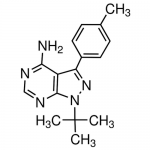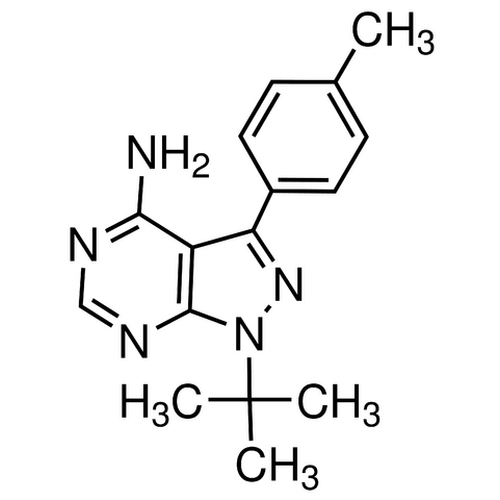| Product Name | PP1 |
| Description |
Src kinase inhibitor |
| Purity | >98% (TLC) |
| CAS No. | 172889-26-8 |
| Molecular Formula | C16H19N5 |
| Molecular Weight | 281.4 |
| Field of Use | Not for use in humans. Not for use in diagnostics or therapeutics. For in vitro research use only. |
Properties
| Storage Temperature | -20ºC |
| Shipping Temperature | Shipped Ambient |
| Product Type | Inhibitor |
| Solubility | Soluble in DMSO (25 mg/ml), slightly soluble in 100% ethanol |
| Source | Synthetic |
| Appearance | Tan solid |
| SMILES | CC1=CC=C(C=C1)C2=NN(C3=NC=NC(=C23)N)C(C)(C)C |
| InChI | InChI=1S/C16H19N5/c1-10-5-7-11(8-6-10)13-12-14(17)18-9-19-15(12)21(20-13)16(2,3)4/h5-9H,1-4H3,(H2,17,18,19) |
| InChIKey | ZVPDNRVYHLRXLX-UHFFFAOYSA-N |
| Safety Phrases |
Classification: Acute toxicity, Oral (Category 3), H301 Safety Phrases: S22 - Do not breathe dust. S24/25 - Avoid contact with skin and eyes. S36/37/39 - Wear suitable protective clothing, gloves and eye/face protection. Hazard statements: H301 Toxic if swallowed. Precautionary statements: P264 Wash skin thoroughly after handling. P270 Do not eat, drink or smoke when using this product. P301 + P310 IF SWALLOWED: Immediately call a POISON CENTER or doctor/ physician. P321 Specific treatment (see supplemental first aid instructions on this label). P330 Rinse mouth. P405 Store locked up. P501 Dispose of contents/ container to an approved waste disposal plant. |
| Cite This Product | PP1 (StressMarq Biosciences Inc., Victoria BC CANADA, Catalog # SIH-469) |
Biological Description
| Alternative Names | 1-(1,1-Dimethylethyl)-1-(4-methylphenyl)-1H-pyrazolo[3,4-d]pyrimidin-4-amine |
| Research Areas | Apoptosis, Cancer, Cancer Growth Inhibitors, Cell Signaling, Tyrosine Kinase Inhibitors |
| PubChem ID | 1400 |
| Scientific Background | PP1 is a potent and selective inhibitor of Src family protein tyrosine kinases. It binds to the ATP-binding site of tyrosine and serine/threonine kinases, displaying high selectivity over ZAP-70 and JAK2. In neuroscience, PP1 is used to study the role of Src kinases in synaptic plasticity, neuronal development, and neuroinflammation. It is particularly useful in models of excitotoxicity and neurodegeneration, where Src signaling contributes to calcium dysregulation and cell death. |
| References |
1. Hanke J.H., et al. (1996) J. Biol. Chem. 271(2): 695–701. 2. Liu Y., et al. (1999). Chem. & Biol. 6(9): 671–678. |



Reviews
There are no reviews yet.